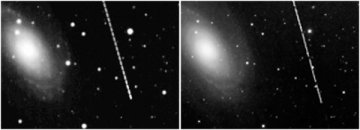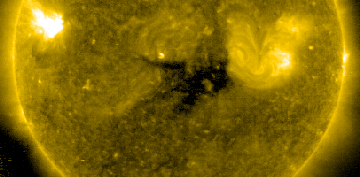 Did you miss last night's auroras? Next time get a wake-up call from Spaceweather PHONE.
Did you miss last night's auroras? Next time get a wake-up call from Spaceweather PHONE.
BIG AURORAS: NASA's Chandra X-ray Observatory has observed some spectacular Northern Lights on the planet Jupiter. The data may help researchers solve the mysteries of the biggest auroras in the solar system: full story.
3D FLYBY: Get ready to cross your eyes. On March 28th, when asteroid 2006 VV2 flew past spiral galaxy M81, two photographers on opposite sides of the USA photographed the encounter. A cross-eyed view of their photos makes the asteroid pop out in startling 3D:

(Hint: Stare at the middle of this image and cross your eyes until the two galaxies overlap. Focus on the asteroid. The longer you stare, the more pronounced the 3D sensation becomes.)
"I produced this stereogram by combining the images of William Keel in Tuscaloosa, AL, and Robert Long in Vado, NM," explains Colorado astronomer Chris Peterson. "Because the asteroid was so close (4.6 million km), and the baseline between the images so long (1780 km), the parallax between the asteroid and the background stars is significant, and the stereo effect is quite real." [more]
Another must-see image is Robert Long's motion picture of the asteroid-galaxy flyby. Click here to play the 1.6 MB movie.
CORONAL HOLE: Earth is staring down the barrel of a coronal hole on the sun. It's the dark patch in this March 30th ultraviolet image from SOHO:

Coronal holes are places in the sun's atmosphere where the sun's magnetic field opens up and allows solar wind to escape. A gust of wind from this particular hole will reach Earth on April 2nd, possibly sparking high-latitude geomagnetic storms. Sky watchers from Scandinavia to Alaska should be alert for auroras.
March 2007 Aurora Gallery
[aurora alerts] [night-sky cameras]

